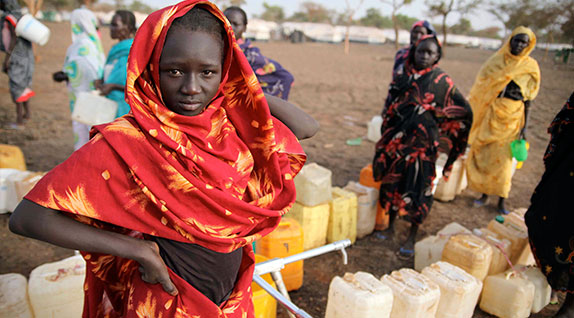 Hannah Mcneish/AFP/Getty Images
Hannah Mcneish/AFP/Getty Images
Article
Water problems affect every continent. Solving it will take global change.
Learn the why behind the headlines.
Subscribe to the Real Truth for FREE news and analysis.
Subscribe NowIt’s dry. At sunrise, a child in Madagascar begins a 30-minute trek to the nearest spring—all closer water sources have dried up due to deforestation. She scoops the water, which is yellowed with sediment, into a bucket. Later that day, she will have to make the journey again.
It’s dirty. Dozens of barefoot Indian men, women and children gather in a mucky field, anxiously waiting with empty water jugs and 20-foot tubes. Clamor erupts when the water trucks arrive. Teenagers climb up to the latch and stick pipes into the tank and women on the ground bicker over who gets first dibs. They fill as much as they can. The trucks may not show up again for days, even weeks. A mother complains that the water causes her children to vomit.
It’s dusty. A nearly 60-year-old Kazakhstan woman looks beyond what used to be a lake’s shoreline to see a valley of dust stretching to the horizon. She recalls her childhood when she sold ice cream to vacationers there. Now, rusty fishing ships sit on the spot, which has become a playground instead of a source of food for the area. “The sea was our life and our wealth,” she says. “We were once rich…but we are witnesses to its destruction.”
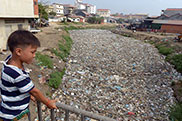 Tang Chhin Sothy/AFP/Getty Images
Tang Chhin Sothy/AFP/Getty ImagesThese stories, the first two reported by Water.org and the last from BBC, are just three examples of water problems worldwide. Across the globe, more than 1.2 billion experience water scarcity, meaning that an area lacks enough clean water to meet the demand of its population.
Water.org revealed the scope of the problem:
- “Every minute a child dies of a water-related disease.”
- “Women and children spend 140 million hours a day collecting water.”
- “More people have a mobile phone than a toilet” (a lack of proper sanitation often pollutes drinking water).
- “1 in 9 people lack access to safe water.”
The sad irony in all of this is that there should be plenty to go around. The United Nations estimated that if Earth’s available freshwater was evenly distributed among this planet’s approximately seven billion inhabitants, each person could be allotted 7.5 million gallons during his lifetime.
With that amount, each individual could consume 152 gallons per day (the UN Development Program estimates each American uses this much, the highest rate of individual water use in the world) for 136 years. And because water is a renewable resource, as long as it remains pure, it cycles through the environment perpetually without loss.
Despite this, nearly every nation struggles with H2O issues—from South Africa to Brazil to China to California in the United States. Each year, the World Health Organization estimates that water pollution alone kills more than two million people.
We must admit this about our water crisis: it is largely manmade. And, if we are unable to adequately support seven billion people now, how can we expect to sustain an estimated 9.3 billion by 2050?
The number of people lacking water is set to increase in coming years. According to Jan Eliasson, Deputy Secretary-General of the UN and former chairman of WaterAid Sweden, two billion people will live in regions with absolute water scarcity by 2025. In addition, two-thirds of the world population will live in water stress conditions, defined as lacking sufficient clean water for at least one month out of the year.
We need a solution—and fast. Examining the water crisis across the globe makes this abundantly clear.
Running Dry
Africa often first comes to mind at the mention of a lack of water. The entire continent endures unpredictable bouts with severe drought that affect those who rely on agriculture to feed themselves.
In 2011, the fertile lands of Ethiopia struggled with the worst drought in 60 years, which left at least 250,000 facing starvation. While droughts are naturally occurring phenomena in the country, proper handling of the water supply could have severely mitigated its effects. Yet these solutions would have cost many millions in infrastructure and education to enact, and the country could not afford to implement them.
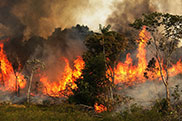 Mario Tama/Getty Images
Mario Tama/Getty ImagesThis year, Zimbabwe has been hit. Lack of rain has left large portions of southern Africa dry, which has particularly affected impoverished areas. Times Live, a South African news outlet, reported, “The impact is looking particularly serious for Zimbabwe, where the economy has been struggling for five years to recover from a catastrophic recession that was marked by billion percent hyperinflation and widespread food shortages.
“The government and foreign relief agencies are still assessing needs but one official said up to 1.8 million people—more than a tenth of the population—may require food aid.
“The 2015 harvest is forecast at 950,000 tonnes of maize, the staple, far less than the 1.8 million tonnes Zimbabwe’s people need.”
Realize that this means aid dollars will be going to food rather than long-term solutions of proper water-management techniques.
Reuters reported an additional reason the dry spell hit so hard: “Although drought is blamed for this year’s crop failure, Zimbabwean farmers are reluctant to grow small grains such as sorghum and millet, which are more resistant to drought but are not widely eaten in Zimbabwe…Farmers also lose up to 35 percent of harvested maize due to poor storage, according to the [World Food Program].”
An additional problem is the nation’s aging irrigation infrastructure. According to AllAfrica, the Zimbabwean government estimates that over the next 25 years, $10 billion is needed to fix the problem. This is a huge bill for a nation with a gross domestic product of about $13.7 billion.
Yet another disaster is developing on the edge of the Sahara Desert as Lake Chad, once among the largest lakes in Africa (larger than the size of Israel), has nearly dried up. It has been a lifeline for more than 68 million people in four surrounding countries: Chad, Cameroon, Niger and Nigeria.
The major reason it is drying up? Constant diversion of the lake’s waters by local farmers, communities and governments since the 1970s has prevented it from replenishing.
Locals are still squabbling over water rights. The UN summarized in a report: “The impact of the drying lake is causing tensions among communities around Lake Chad. There are repeated conflicts among nationals of different countries over control of the remaining water. Cameroonians and Nigerians in Darak village, for example, constantly fight over the water. Nigerians claim to be the first settlers in the village, while Cameroonians invoke nationalistic sentiments, since the village is within Cameroonian territory. Fishermen also want farmers and herdsmen to cease diverting lake water to their farmlands and livestock.”
An additional reason Lake Chad is disappearing is deforestation in the region, which has contributed to a drier climate. As of 2015, Lake Chad has lost 95 percent of its surface area.
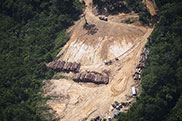 Raphael Alves/Getty Images
Raphael Alves/Getty ImagesDeforestation is also causing drought in Madagascar. Over the past century, 80 percent of Madagascar’s forest cover has been wiped out. The country’s fragile economy depends on crop exports, therefore slash-and-burn techniques have been used to clear trees from fields for rice or coffee plants. In addition, logging of rare, endangered hardwoods exclusive to the island, which can fetch $3,000 per cubic meter on the international market, has contributed.
On the other side of the globe, the same problem is occurring in Brazil, which is suffering its worst drought in 80 years after decades of rainforests being cut.
“The cutting of trees, scientists say, is hindering the immense jungle’s ability to absorb carbon from the air—and to pull enough water through tree roots to supply gigantic ‘sky rivers’ that move more moisture than the Amazon river itself,” The Associated Press wrote. “More than two-thirds of the rain in southeastern Brazil, home to 40 percent of its population, comes from these sky rivers, studies estimate. When they dry up, drought follows, scientists believe.”
“The sky rivers are generated by the forest acting as a massive pump, according to research that has shown the jungle’s uniform humidity consistently lowers atmospheric pressure in the Amazon basin. That allows it to draw moist air currents from the Atlantic Ocean much farther inland than areas that don’t have forests. Those currents travel west across the continent until they hit the Andes mountains, where they pivot and carry rains south to Buenos Aires and east to Sao Paulo.
“The trees pump an estimated 20 billion metric tons of water into the atmosphere every day—3 billion more than what the Amazon river, the world’s largest, discharges into the ocean.”
Slash-and-burn practices also loosen soil, which causes rivers to unpredictably change course and sediment to cloud water, making it unfit for human consumption.
Tapped Out
Lake Chad drying out is just one example of the results of unabated diversion of rivers for farming. Another instance, and perhaps the most poignant, is the Aral Sea in Kazakhstan, where the consequences have been devastating for local populations.
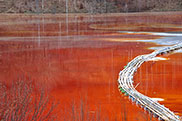 Thinkstock
ThinkstockThe Aral Sea was once the fourth-largest inland body of water in the world, behind the Caspian Sea, Lake Superior, and Lake Victoria. The sea’s fish provided food and a livelihood for people in the region.
Satellite images today reveal a brown basin with just a few tiny pockets of blue water remaining.
As is the case with deforestation, this is an entirely manmade crisis. It started in the 1950s, when the Soviet Union implemented a plan to irrigate dry steppes in this region to produce cash crops such as melons, rice and cotton, which it considered “white gold.” Exports on these crops were expected to bolster the wealth of the superpower.
Irrigation canals were constructed on the two large rivers supplying the Aral Sea—the Amu Darya and Syr Darya. After the canals were built, neither of the rivers finished their course at the sea. Without water feeding into the sea, evaporation dried it out. As the depth of the water decreased, evaporation accelerated. In 1987, the sea split into two smaller bodies, the South Aral Sea and the North Aral Sea—which were both separated by the emerging seabed.
BBC detailed the compounding effects: “Grass dried up, and the small freshwater lakes that once existed near the sea’s edge disappeared.
“Herds of antelope that used to roam the area dwindled to nothing. The summers became blisteringly hot, the winters bitingly cold.
“And just getting around became tough. In the old days everyone went from one fishing village to the next by boat.
“Now they get about by car—but there are barely any roads. Instead, sturdy 4x4s bump and shake their way over tracks across the former sea bed.”
Problems bred more problems. As more of the seabed became exposed, wind kicked up dust. This caused massive dust storms to plague those who stayed behind.
With the dust storms came an onset of respiratory diseases. Child mortality rates increased significantly, and newborns came out of the womb without lungs, eyes, noses or even hearts.
Doctors and locals began to realize the dust storms filled their lungs with more than just dirt. Tests performed on the soil revealed that the dust was filled with chemical residue: nitrites and carcinogenic substances. Chemicals deposited in the soil during Soviet-era nuclear testing, as well as pesticides and fertilizers, had been brought to the surface and swept into the air.
Mothers even found that their infant babies were dying in their arms after breastfeeding—the contaminants having passed through mothers’ bodies, causing their milk to be toxic.
Winds spread the poisonous, salty dust for hundreds of miles, ultimately decreasing the crop yield in the cotton fields to which the waters were diverted in the first place.
Across the globe, many other bodies of water are receding due to over-irrigation, including Lake Chapala in Mexico, which has lost 25 percent of its surface area over the past 60 years, and Poyang Lake in China, which is the country’s largest freshwater lake.
Wasted Waters
Poor sanitation is another major water woe, and nowhere is this more obvious than India. The nation’s Central Pollution Control Board (CPCB) estimated that 70 percent of India’s sewage is untreated and is disposed of in its rivers and lakes. The board also found that 275 of India’s 445 rivers are severely polluted.
For example, the Yamuna River is considered holy in the Hindu religion—yet it is filthy.
“There are many devotees…who regularly bathe in the Yamuna, and this cleanses all the contamination of the material world” states one of Hinduism’s sacred texts, the Srimad Bhagavatam.
Believing it has spiritual-healing properties, people drink from it, bathe in it, wash their clothes in it, consume its fish, and cremate bodies on its shores. Yet the Yamuna has 15 drains along its bank that constantly pour untreated sewage into its waters.
Hindustan Times reported: “It’s not just the Yamuna, whose water quality is as bad as sewage, but many rivers across the country are reeling under an unprecedented load of urban waste and industrial effluents, says a CPCB report.”
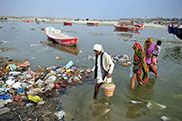 AFP/Getty Images
AFP/Getty ImagesThe shortage of clean water is attributed mostly to India’s population explosion over the past 30 years, when it doubled from 600 million to 1.2 billion. Thirty million water wells and pumps were constructed during that same period, sapping groundwater faster than it could be replenished.
Clean water is now so scarce that millions depend on tanker trucks with contents pulled from polluted bodies of water. All this in a nation with the ninth-largest economy in the world.
India’s ultra-rapid growth has created a series of seemingly impossible problems. How can cities jam-packed with people—the New Delhi metro area alone has 21.7 million—be retrofitted with sewage systems to stem the disease and pollution that come from it?
China is also in the midst of a battle against water pollution. Decades of unregulated industrialization and population explosions have filled rivers with pollutants. A rising number of cancer cases have occurred along the Huai River, which picks up pollution from cities in central China.
A survey by China’s Ministry of Environmental Protection indicated that 60 percent of groundwater in the nation is polluted, while more than half of its freshwater lakes are polluted.
Wealthy Nations, Too
The water crisis is not just found in impoverished areas and developing nations. Even the United States has rampant H2O issues. While the nation fares much better than other parts of the globe, its growing problems are the same as the rest of the world.
For example, the Rio Grande has been diverted to the point that it is running at 30 to 40 percent of its capacity. Reporters have facetiously labeled it “Rio Poco” (Spanish for tiny river).
The New York Times stated: “An untamed, flash-flooding home to sturgeon and eels a century ago, much of the Rio Grande today is little more than a magnificently engineered pipe—diverted, straightened, dammed, bled by canals, linked by tunnel to the Colorado River basin in the north, surrendering its last trickle in the south to a ditch that supplies farmers near El Paso.”
Those who depend on its waters fight over how to divvy them. The media outlet continued, “The rules for sharing the Rio Grande are even more complex than its plumbing. Irrigation districts, governments and tribal authorities, among others, all have rights to water, and some have reservoirs devoted more or less exclusively to their use.”
While squabbling over who gets what, very few focus on solving the problem. Obviously, if a major river is reduced to a trickle, something we are doing is wrong!
The California drought has brought rampant water mismanagement to light. Farmers in the region who once made small fortunes on cash crops in Southern California, which is now in its fifth year of exceptional drought, are spending those fortunes to dig deeper wells and save their precious yield.
“Up until 15 years ago, it was easier for the Metropolitan Water District to pay farmers to leave their fields fallow during droughts so cities could use the water” The Los Angeles Times reported. “Not anymore. California’s farmers have increasingly focused on lucrative almonds, walnuts and pistachios as other crops got cheaper after the passage of the North American Free Trade Agreement. But almond trees need to be watered all the time and don’t offer the flexibility of row crops where fields can be left fallow during dry years.”
There is no law in California that dictates what and what not to plant, and whether one is allowed to plant if they cannot prove they have enough water to sustain their crop.
So the water table continues to drop, and the ground sinks with it. The New York Times reported: “The draining of the aquifers creates another hazard aboveground. As water is pulled from the spongy layers below, the ground above collapses, creating what is known as subsidence. Where subsidence is the worst, the land can sink as much as a foot each year.”
Subsidence is not a new problem. Since the 1920s, the land has been sinking as groundwater is pumped to feed crops. Sinkholes stretching for miles—so large that one does not notice they are in one—developed. In the community of Mendota, the land sunk about 30 feet between 1925 and 1977.
The state suffered because of it. A report from The Center for Investigative Reporting noted: “The sinking, which peaked in the late 1960s, wreaked havoc on the state’s rapidly expanding infrastructure, damaging highways, bridges, and irrigation canals. One estimate by the California Water Foundation put the price tag at $1.3 billion for just some of the repairs during that time.”
Despite this historical warning, pumping continues today.
“In a normal year, [Jay Famiglietti, senior water scientist at the NASA Jet Propulsion Laboratory] says, 33 percent of California’s water comes from underground, but this year it is expected to approach 75 percent,” The New York Times reported. “Since 2011, he says, the state has lost eight trillion gallons from its overall water reserves, two-thirds of that from its underground aquifers.”
“We can’t keep doing this,” Mr. Famiglietti stated.
The San Joaquin Valley supplies most of California’s agricultural output. The state is the fifth largest supplier of food in the world (including 90 percent of the world’s almonds).
At current levels, agriculture consumes 80 percent of California’s water supply. Unless the state can find a way to keep up with H2O demands, experts project that another 400,000 acres of farmland will be lost each year and consumers will face as much as a 15 percent price increase in food.
Another longstanding problem in the U.S. is water pollution. In 1972, Congress passed the Clean Water Act with the objective to make all waterways in America “fishable and swimmable” within 10 years. Approximately 40 years later, many bodies of water are still falling short of the standards.
A 2013 report from the Environmental Protection Agency showed there were high levels of bacteria, mercury, phosphorus, nitrogen or other pollutants in 44 percent of streams, 64 percent of lakes, and 30 percent of bays, and estuaries that were monitored—enough that these areas were deemed unsafe for fishing or swimming.
America also has its own version of Lake Chad. The Los Angeles Aqueduct, constructed in the 1920s, caused many natural lakes and rivers that fed Owens Lake to divert their flows toward the city. In time, the lake dried up completely.
Today, because the lakebed is no longer covered with water, wind kicks up dust. It is the largest single source of dust pollution in the United States. The city paid over $1.2 billion to reduce adverse health effects caused by windblown dust.
Other bodies of water are drying up because of irrigation. Lake Mead, which provides water to 22 million people, may dry up by 2021 if it is not allowed to replenish. In addition, the Great Lakes have dropped an average of 1.5 feet since 1999—the equivalent of 2.5 million gallons!
Aging infrastructure in the nation causes even more problems. The Environmental Protection Agency estimates $335 billion will be needed in the next few decades to repair the U.S. tap water system, The New York Times reported.
The paper quoted Jeffrey K. Griffiths, a professor at Tufts University and a member of the EPA’s National Drinking Water Advisory Council: “We’re relying on water systems built by our great-grandparents, and no one wants to pay for the decades we’ve spent ignoring them.”
“There’s a lot of evidence that people are getting sick…But because everything is out of sight, no one really understands how bad things have become.”
Concerted Effort
Looking at the entire globe and the sheer extent of our water crisis, only a cohesive, worldwide effort could ever reverse it. And lots of time.
Yet the best attempts are mere rallying cries. The UN holds World Water Day each March 22 to raise awareness of the issue and adopt resolutions. November 19 is World Toilet Day, and the UN Water website explains the mission for the day is “to raise awareness of sanitation issues—including hygiene promotion, the provision of basic sanitation services, and sewerage and wastewater treatment and reuse in the context of integrated water management—and make a case for sanitation for all.
“It intends to encourage UN Member States and relevant stakeholders, including civil society and non-governmental organizations, to promote behavioural change and the implementation of policies in order to increase access to sanitation among the poor…”
Note the wording throughout: “intends to raise awareness,” “encourage UN Member States,” “promote behavioural change.” Sadly, while the intent is genuine, none of these phrases include immediate action to tackle this global crisis.
And how can it? Every nation is too focused on the here-and-now problems to tackle the overall systemic issues of water mismanagement.
Nonprofits, such as Water.org and WaterAid, focus on raising awareness too, and also solicit donations to send aid workers to villages in Ethiopia, Ghana, Kenya, El Salvador, and other drought-suffering nations to construct hand-operated pumps for local villages. Others go into areas and build community latrines or toilets.
Yet such efforts do not always pan out, and ultimately require governmental cooperation, according to non-profit organization The Water Project.
“Environmentalists suggest low-cost but immediate solutions for managing drying waters, such as digging ponds or underwater receptacles. These low-tech fixes already help farmers in China.”
Yet the organization stated that conservation efforts need to be a joint partnership between governmental agencies, land-owners, environmentalists and conservationists.
The organization further stated: “Outdated damming and gauges result in billions of gallons of lost water, but a quick fix for one local population might harm another downstream. One agency’s priorities could harm another’s. These facts highlight the need for shared information and cooperative effort.”
To actually stop the droughts in Brazil and Africa, millions of acres of trees would have to be replanted and given decades to grow. Lakes and reservoirs would have to be left alone to replenish. Populations would have to migrate by the millions to different areas where water was readily available.
Citizens in nations such as India and Pakistan would need more than toilets built for them. They would have to become accustomed to using them. And once sanitation systems were in place, entire nations would need to be sure all of the sewage was treated and did not end up in rivers.
In order to continue in the agricultural business, some Californians would have to move: “Cheap agricultural water has led to the insanity of a desert like California becoming one of the world’s chief producers of water-intensive crops, such as rice and alfalfa,” the publication The Week reported. “George Mason University economist Alex Tabarrok estimates that if farms used just 12.5 percent less water, California could increase the amount available for industrial and residential use by half.”
All of this is a tall order: change long-held behavioral patterns, pump trillions of dollars into infrastructure costs, coordinate global education programs in all languages, replant rainforests, move farmers…the list could go on.
Ultimate Fix
The UN is no stranger to tall orders. Outside its Headquarters in New York is the statue of a man forging a sword into a plowshare. The idea is to promote and engender peace so that the world can focus its efforts on worthwhile pursuits.
Beating swords into plowshares is a reference to Bible passages found in the books of Isaiah and Micah. It is the hope of the UN that world peace will come to pass.
Yet faced with the seemingly insurmountable odds of the multifaceted, worsening global water crisis, the world can hope for another Bible passage to come to pass.
The scripture is found in Zechariah: “His [Christ’s] feet shall stand in that day upon the mount of Olives, which is before Jerusalem on the east, and the mount of Olives shall cleave in the midst thereof toward the east and toward the west, and there shall be a very great valley…and it shall be in that day, that living [Hebrew: alive, fresh] waters shall go out from Jerusalem; half of them toward the former sea, and half of them toward the hinder sea: in summer and in winter shall it be” (14:4, 8).
Ezekiel adds to this picture by stating that the waters of the Earth “shall be healed.”
Chapter 47 states: “And it shall come to pass, that everything that lives, which moves, wheresoever the rivers shall come, shall live: and there shall be a very great multitude of fish, because these waters shall come there: for they shall be healed; and everything shall live where the river comes.”
Imagine. The entire globe with a clean slate in regard to water!
Religion aside, think what would happen in such a scenario. Given human nature, history would repeat itself. We have had pristine water sources before, but have always fouled them up.
If the pictures in Zechariah and Ezekiel did come to pass, it would not be enough. Governments would have to band together to ensure everyone managed water correctly—otherwise, we would quickly find ourselves in another global crisis.
Most are unaware that the Bible actually contains many principles on water management that would have to be implemented and enforced if the world’s water supplies were to be maintained.
For example, Exodus 23:10-11 and Leviticus 25:2-7 contain the command for a land Sabbath every seven years. This means farm fields would lie fallow with no crops planted. Such a practice renews the soil, but also allows the water table to rejuvenate. This helps ensure wells never run dry.
Sanitary laws are also found in God’s Word. Deuteronomy contains ordinances to ensure human waste does not contaminate water. Chapter 23 contains the instruction to bury feces outside of a living space (Deut. 23:12-13), and similar laws were in place for animal carcasses and human corpses.
In addition, ancient Israel was instructed to use running, “living” water to keep the Temple clean, which was especially important considering the number of animals slaughtered there daily.
But the Bible’s description of a time when “healing waters” encircle the globe is not just wishful thinking. A central theme of the Book is how this and similar events will occur—and how such pristine and prosperous conditions can continue.
The answer is contained within the message Jesus Christ brought when He was on Earth: the gospel of the kingdom of God.
“Kingdom” is simply another term for government. Christ brought a message of the gospel of the government of God. Throughout the Old and New Testaments, the Bible describes this coming world-ruling supergovernment led by Jesus Christ.
Consider what is written in Isaiah: “For unto us a Child is born, unto us a Son is given: and the government shall be upon His shoulder: and His name shall be called Wonderful, Counselor, The mighty God, The everlasting Father, The Prince of Peace” (9:6).
The “Child” mentioned in this passage is Jesus Christ. Notice He has a government. The next verse states, “Of the increase of His government and peace there shall be no end…and upon His kingdom, to order it, and to establish it with judgment and with justice from henceforth even forever” (vs. 7).
Peace has not been increasing since Christ’s earthly ministry. In fact, the opposite has happened—war has increased! Therefore, this kingdom must yet be established in the future.
When Jesus returns, the world’s troubles can finally be solved—for good. War will give way to peace, smog to clean air, disease to health, and polluted, misused H2O to pristine water distributed to all.
The Bible brims with numerous scriptures detailing how this will come about—and soon. For a fuller picture, read Tomorrow’s Wonderful World – An Inside View! It provides additional proof and detail from Scripture of how our global water woes—and all of mankind’s ills—will be permanently eradicated.
God’s coming kingdom is the only solution to our water crisis!
More on Related Topics:
- The Swarm of Earthquakes Shaking Santorini Prompts Greece to Declare an Emergency
- Nearly 250 Million Children Missed School Last Year Because of Extreme Weather, UNICEF Says
- What to Know About the Devastation from the Los Angeles-area Fires
- Los Angeles Wildfires Rage Out of Control, Testing Firefighting Resources
- A Quarter of Freshwater Animals Are Threatened with Extinction, New Research Shows



